Three New Ballets premiere at the New York City Ballet’s Gala on September 23, 2014
Fashions change more rapidly than dance styles do, so for the New York City Ballet to structure its Fall gala around the theme of “what’s new?” makes a certain marketing sense. The aura of novelty cloaks all. And the green leaves bedecking the balcony overlooking the Lincoln Center Plaza suggested springtime fecundity, even as the foliage in Central Park is thinking about changing color.
This isn’t the first time that Ballet Master in Chief Peter Martins has invited fashion designers to work with choreographers, but it may be the first time that five of the six choreographers whose ballets were performed on October 23 either were once, or are now, dancers in the company. Troy Schumacher is a member of the NYCB’s corps de ballet and Justin Peck (just named the company’s Resident Choreographer) is a soloist. He also inherited a title first held by NYCB alum Christopher Wheeldon, whose 2012 duet, This Bitter Earth (excerpted from a longer work), was danced at the gala by Wendy Whelan and Tyler Angle. Martins himself began to choreograph when he was a principal dancer in Balanchine’s company (his 2001 Morgen opened the festive evening). The third under-30 talent, Liam Scarlett, began his career as a dancer in England’s Royal Ballet; his contribution to the gala is his second work for NYCB.
Up-to-date can sometimes mean retro. (How many trains did we have to avoid stepping on in the theater lobby, as women swanned along trailing wakes of green silk or silver spangles or flowered chiffon?) Also, anyone designing for ballet soon learns that compromises must be made if the dancers are to move. The made-for-the-occasion film that opened the evening showed designs being removed from envelopes, dancers repressing any worry they might have felt, good spirits, and occasional eye-rolling caught by the camera in passing. Yes, Andrew Veyette is going to need to lift his arms in a way that designer Thom Browne would probably have to take his own jacket off to attempt. That fascinating patchwork of fanciful letters stuck to a transparent something that Mary Katrantzou has sent to the NYCB costume shop; what will hold them together on a sleek, endlessly elastic body?
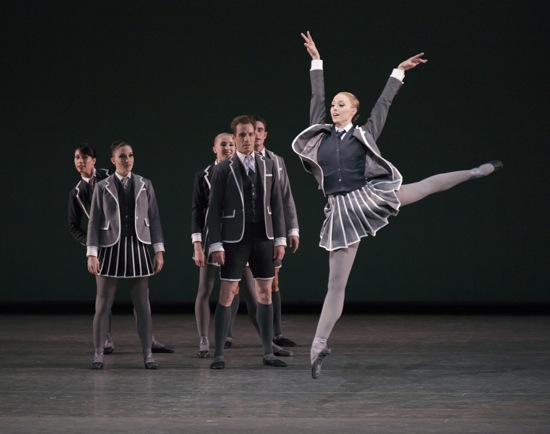
Troy Schumacher’s Clearing Dawn.
Teresa Reichlen shows off for (L to R); Georgina Pazcoguin, Ashley Bouder, Claire Kretzschmar, Andrew Veyette, and David Prottas. Photo: Paul Kolnik
Browne’s costumes for Schumacher’s mystifyingly titled Clearing Dawn ended up being the most surprising, and the ballet the brightest and sauciest event of the evening. It begins with the kind of image that portends a plunge into surreal gloom. Six people of indeterminate gender stand in dim light, wearing long, very broad-shouldered black overcoats. Suddenly, the coats fly up to hang overhead, Judd Greenstein’s rambunctious score—full of sudden stops and restarts— begins, and we’re in the playground of what could be a fashion-conscious prep school. White shirts, ties, vests, and imaginative blazers for all; black pointe shoes and short, flippy skirts with vertical white bands for the women, short; tight pants and knee socks for the men.
Everything about the choreography and the performing tells us that this is a lively, unaffected bunch of young people at play, not denizens of a grim boarding school, harboring guilty adolescent lust. Were it not for Browne’s costumes, we might see them as any group of high-spirited friends. That they begin doing much the same energetic movements but not in unison immediately tells us about both their camaraderie and their individuality. Also, when not in action, they often hang around and watch one another, looking interested and/or amused. Their flurries of motion, the way they join, separate, leave, and return have a youthful energy. They leap, they sprint, they fly through the air in a variety of ways. They work in contrapuntal teams.
Interestingly, Schumacher has avoided presenting six dancers as three heterosexual couples (this alone distinguishes his ballet from every other one on the program). Instead, the group is made up of four zesty women (Ashley Bouder, Claire Kretzschmar, Georgina Pazcoguin, and Teresa Reichlen) and two men (Veyette and David Prottas). The mix is an egalitarian one: three principal dancers, a soloist, and two members of the corps de ballet. Clearing Dawn is moderately gender-neutral too. Veyette and Prottas scuffle fiercely but ineptly. Pazcoguin breaks them up; then she tackles Veyette and Kretzschmar goes for Prottas. A solo can have the air of a private burst of energy or a “so there!” statement. Veyette is remarkable in a whirlwind of kicks and turns and lashing arms. In a strangely sweet pause, Reichlen sits on his shoulders and looks far away, as if she’s testing the wind (or looking from the present into the future).
The music turns melancholy at the end, and after all the dancers have left the stage, the coats slowly descend. With no humans to inhabit them, they sink down like melting snowmen.
Scarlett’s pas de deux for Tiler Peck and Robert Fairchild is set to Franz Lizst’s Funérailles from his Harmonies poetiques et religieuses, and takes its title from the music. But, although the atmosphere is somewhat fraught, “funeral” seems misleading as applied to the ballet. The music that Elaine Chelton plays splendidly on a far upstage piano was said by the composer to be a tribute to three friends of his who died in the failed Hungarian Revolution of 1848. In it you hear mournful melodies, summonses to battle and marches both funereal and heroic.
What you see is a fraught encounter for two people: a woman in a spectacular ball gown by Sarah Burton for Alexander McQueen and a man wearing dark shiny tights and a long coat that matches his partner’s dress in terms of its blackness and intricately scrolling gold trim. The costumes are as confusing as the duet. The edges of Fairchild’s elaborate coat come nowhere near to meeting over his bare chest, and the conflict between elegance and nudity is as disconcerting as it is perplexing. Peck’s silk skirt falls over a long, fluffy white one. Often, as she moves or is moved, it has to be pushed out of the way; when Fairchild lifts her, he appears for several unhappy moments to be dealing with a bundle of fabric.
Scarlett’s choreography does hint at gloomy mysteries. Mark Stanley’s lighting is dim at first, and Peck’s advance toward the front of the stage seems shadowed. When Fairchild appears behind her and takes her hand, she pulls it back. Later she pushes him away. But she still lets him lift her time after time, even turn her head over heels. When she retreats upstage into dimness and a pool of light, he paws at her dress; when she sinks to the floor, he tenderly picks her up.
I suspect that Scarlett has a story that he’s trying to tell without being too obvious, but the result is baffling and at times inconsistent. Maybe he has told that story to Peck and Fairchild. In any case, these two wonderfully expressive performers bring every nuance to the choreography and the music that they can muster.
Justin Peck’s Belles-Lettres is also somewhat confusing, hiding more than this extremely gifted young choreographer usually reveals, however subtly. It’s set to César Franck’s Solo de piano avec accompagnement de quintette à cordes. So the piano (excellently played by NYCB’s Susan Walters) ripples over and quibbles with five stringed instruments. The opening image of the ballet is an artfully arranged cluster of eight dancers, with one male held up above them, seated on invisible hands. Those letters of the alphabet in different scripts that Katrantzou designed are now scattered over the men’s beige unitards, not fully apparent, and barely visible (if there at all) on the women’s flowing, beautifully cut dresses.
The dancers spend a little time in that clump—sitting, rising, moving into the center and out again. But it becomes clear that the man who was lifted (Anthony Huxley) is indeed special (it crossed my mind that maybe Peck intended him to be a writer, symbolically buttressed by living words that are sometimes supportive, sometimes recalcitrant). He pulls the dancers from their cluster into a chain and then sets them loose. Once they all stand, facing away from us toward a far corner, while he dances with a wild, impish fluency (a terrific performance by Huxley). He also has the power to hasten among embracing couples and separate the women from the men.
But imagine for a moment that this nimble dancer is a “writer.” What is he writing? Just sweet-tempered love scenes? If so, he has trouble making up his mind as to who should join whom when. Peck, being expert, introduces brief duets skillfully—forging them as a trio minus one, or canceling them by adding one or two more people. But, for the most part, we identify the performers as the program does—in couples: Lauren Lovette and Jared Angle, Ashley Laracey and Adrian Danchig-Waring, Brittany Pollack and Taylor Stanley, Rebecca Krohn and Tyler Angle. All are splendid dancers, but not strongly individualized by the choreography. They pass by, they engage, they join others, they go elsewhere. The women take off their unbecoming headbands and let their hair down. Sometimes the music brings out a rhapsodic response in the dancing; sometimes it spreads a calmer tenderness or a tempestuous flurry.
The lone man—appearing and disappearing— has plans for them, and I’m not sure when he is pleased by the results. Please feel free to ignore my hypothetical theme; I admire Peck’s ballet, but at this point, it introduces ideas that invite groping for meaning.
The audience applauding Wheeldon’s This Bitter Earth didn’t want to let Wendy Whelan and her partner, Tyler Angle, go. I share the fans’ regret that her farewell performance with the company she has graced for thirty years is coming up on October 18 (although she will appear in certain ballets during the Fall season). Wheeldon’s pas de deux winds loosely through its music—Dinah Washington singing a heart-catching song by her and Max Richter from the film Shutter Island.
Whelan is ethereal in a way that’s far from the nymphs of 19th-century ballet. She has a tensile strength like that of copper wire heated in the fire that for her is rapture. She gleams. Angle handles her lovingly, and Wheeldon inserts into his eloquent choreography little reminders that she’s human. In the middle of a partnering maneuver, Angle kisses her on both cheeks; the two lay their heads together; she nuzzles his hand.
Martins’ Morgen 2001 is a feast of pas de deux, Or a glut, depending on your taste. Nine of them, performed to Richard Strauss’s gorgeous Songs for Piano and Orchestra are pas de deux, with the three couples involved coming together during an additional one, “Morgen.” At first Jennifer Zetlan, singing from the pit, was poorly amplified, but that improved over the course of the ballet.
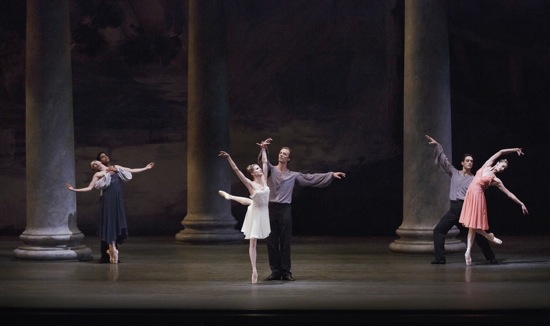
Peter Martins’s Morgen. (L to R) Sara Mearns and Amar Ramasar, Sterling Hyltin and Ask la Cour, Maria Kowroski and Justin Peck. Photo: Paul Kolnik
The three pairs who roam among Alain Vaes’s five fat, roofless pillars framing a hazy vista of sea and trees—seeking and finding, losing and finding someone else, separating, joining, and lurking about—could be dreamers. If so they faintly resemble those movie characters who, after a night of drinking, wake up to find someone they’re not sure they know in bed beside them. But neither surprise nor guilt figure in the encounters between Martins’s dancers. Nor is this ballet about the perils of speed dating. Martins is an endlessly ingenious creator of romantic pas de deux—suggesting the many implications of closer contact without resorting to knotty couplings
One can imagine him thinking to make the evening more gala by showing off nine more of his stellar dancers. And, indeed, it’s a pleasure to watch young Justin Peck snag experienced ballerina Maria Kowroski as she spins among the pillars, dance with her gallantly, and then hasten away—as does she. The women wear new costumes by Carolina Herrera—knee-length dresses that are flattering, and simply constructed. Kowroski’s is orange, and Sterling Hyltin’s, when she rushes in with Ask la Cour, is white. These two seem younger and bolder, leaping about to a song that veers among impulsive, heroic, and lyrical moods. In one remarkable burst of rapture, Hyltin takes off toward her partner, and—how did they do that?— the next moment she’s draped backward over his shoulder.
The duet for Sara Mearns and Amar Ramasar, like the music that accompanies it (“Ruhe meine Seele!”), is darker—thoughtful but more deeply passionate. When he clasps his arms tightly across her chest from behind, there’s a wealth of nuance in the way she reaches up and opens them. Mearns leaps onto her partner in ways very unlike Hyltin in her abandon. Clutching Ramasar, her bent legs spread as if in mid-stride, she looks like a big bird hanging from him—either wounded or in an abortive attack. He withdraws. She spins offstage.
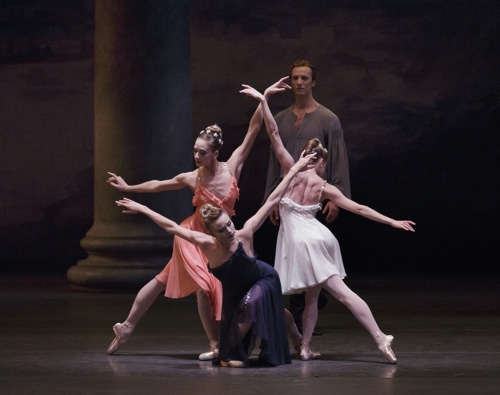
(L to R): Maria Kowroski, Sara Mearns, and Sterling Hyltin in Peter Martins’s Morgen, with Ask la Cour observing. Photo: Paul Kolnik
It’s not long before you realize that Martins is going to explore every possible heterosexual pairing of these remarkable people, and part of you is eager to see how they will behave with new partners, and part of you is counting down, trying not to lose interest in the many ways a man can assist, mold, woo, and dominate a woman by means of attractive physical strategies. Martins cleverly transplants and varies certain maneuvers into the shifting partnerships, but the relationships are not strikingly different. I can’t remember for sure after nine pas de deux and a final section when all are together onstage, whether everyone ended with a new lover or not. I think so. Or maybe we’re supposed to imagine—as in Max Ophuls’ great film La Ronde—that the changing of partners could go on and on like a merrygoround from which there’s no stepping off. Help!
Coming up soon in the New York City Ballet season: a new work by Alexei Ratmansky and some Balanchine marvels. Along, of course, with repeats of the three ballets by three talented young men.

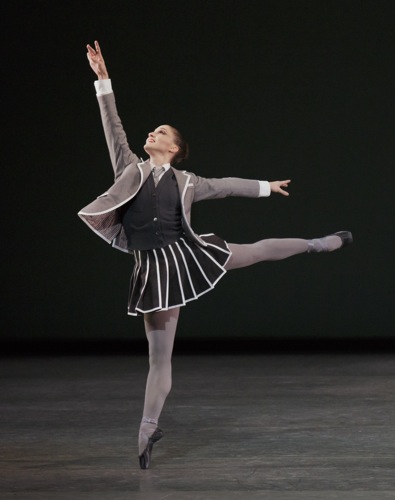

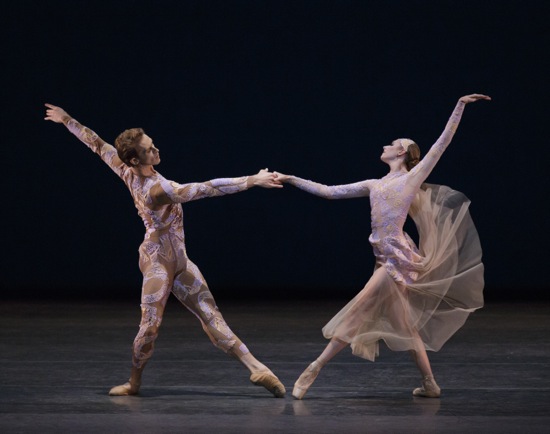
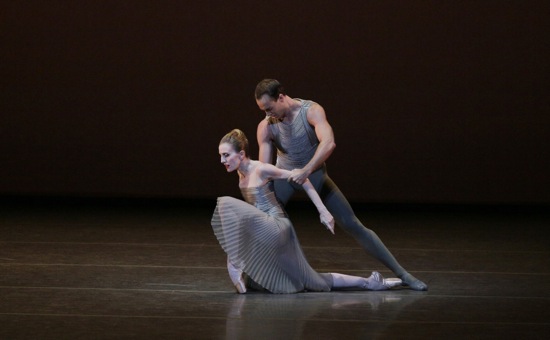
NYCB’s recent efforts to “fashion up” its galas by incorporating costumes by fashion designers are, in one sense, like what Sergei Diaghilev did in the glory years of the Ballets Russes, when he brought in noted artists from various fields to collaborate on new work. Yet for some reason it troubles me. The move makes “a certain marketing sense,” to borrow a phrase from Deborah’s opening. But I can see what NYCB gets out of it and what the designers get out of it more easily than I can see what Terpsichore herself gets out of it. (I note in passing that the ancient Greeks had no muse for clothing, but then they had no muse for the visual and plastic arts either.) Maybe I should put the problem in personal terms: when the ballet moves further upscale, it feels as if I’ve been moved further downscale.
But enough of that. When I don’t make it to the theater myself (and for that matter when I do), I’m always glad to have an account of how Deborah saw it. Has anybody given you a prize lately? You deserve one, for sustained excellence in dance criticism. Here, among other things, I appreciate the sketch of Wendy Whelan’s qualities: a kind of ethereality combined with “tensile strength.” Yes! Her limbs are as fine as drawn wire, delicately force-carrying, almost not there but far from immaterial. Much as I hate to see Wendy’s farewell performance for City Ballet, I do at least look forward to reading Deborah’s account of that event and whatever she works in about Wendy’s entire career.